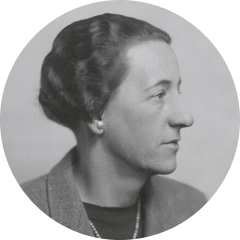Mary Trevelyan
(1897–1983)
Mary Trevelyan (1897–1983), Warden of Student Movement House, worked devotedly to support the needs of overseas students in London (her organisation was based at 32 Russell Square, close to the offices of F&F; later at 103 Gower Street); founder and first governor of International Students House, London. Appointed OBE in 1956; CBE, 1968. Writing to John Hayward (26 July 1942), TSE referred to her as ‘this indefatigable woman’. Lyndall Gordon characterises her as ‘a mannish woman, tall, dark, with a high-handed, even bossy manner. She dominated younger friends, but was considered a “good pal”, generous with help, kind and sensible’. Trevelyan left an unpublished memoir of her friendship with TSE – ‘The Pope of Russell Square’ – whom she long desired to marry. See obituary in The Times, 12 Jan. 1983; Gordon, The Imperfect Life of T. S. Eliot, 430–65; Mary Trevelyan and Erica Wagner, Mary & Mr Eliot: A Sort of Love Story (2022); Lyndall Gordon, The Hyacinth Girl: T. S. Eliot’s Hidden Muse (2022).
See further Lyndall Gordon, ‘Prufrock among the Women’, Oxford Today 2: 3 (Trinity issue, 1990), 27:
Where Emily Hale and Vivienne were part of Eliot’s private phantasmagoria, Mary played her part in what was essentially a public friendship. She was Eliot’s escort for nearly 20 years, until his second marriage in 1957. A brainy woman, with the bracing organizational energy of a Florence Nightingale, she propped the outer structure of Eliot’s life, but for him she, too, represented something. He liked introducing her to his sister, Marian, as ‘the Vicar’s daughter’. She was indeed the devout eldest daughter of the Reverend George Philip Trevelyan who had built various churches of his own High Anglican persuasion. I think that Mary must have represented for Eliot, the inherited traditions of the faith to which he had converted in 1927. Without much spiritual imagination, she was an appropriate companion for the regimen which Eliot prescribed for himself in 1941 of ‘prayer, observance, discipline, thought and action’, and she accompanied him to all services.
See too TSE’s report on Trevelyan’s submission, provisionally entitled ‘Strangers and Sojourners’, 1 Aug. 1941:
Mary Trevelyan is an extremely nice woman who runs the Student Movement House in Gower Street. The Student Movement House is a kind of club frequented by foreign students of all nationalities and both sexes, who are attending London University. It is an extremely useful benevolent institution and I think Miss Trevelyan runs it very well. This book is a kind of autobiography covering only the period during which she has been warden of the house. It is rather scrappy and includes an account of a journey round the world. I found her notes on individual cases of foreign students and their difficulties extraordinarily interesting but I doubt whether the book has enough structure to justify its publication. I may be wrong on this point and there may be many people who would like to read about these things, and as Miss Trevelyan is rather a friend of mine I should like to have another opinion on the book. Perhaps C. W. S. [Stewart] would be willing to look at it. It is easy reading for anybody.
Trevelyan’s memoir was published under the title From the Ends of the Earth (1942).
